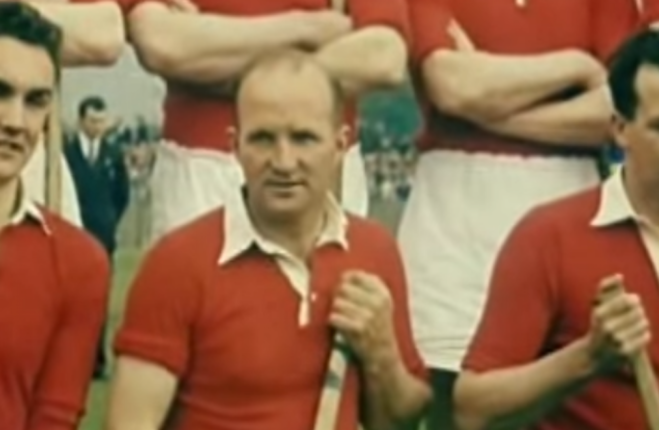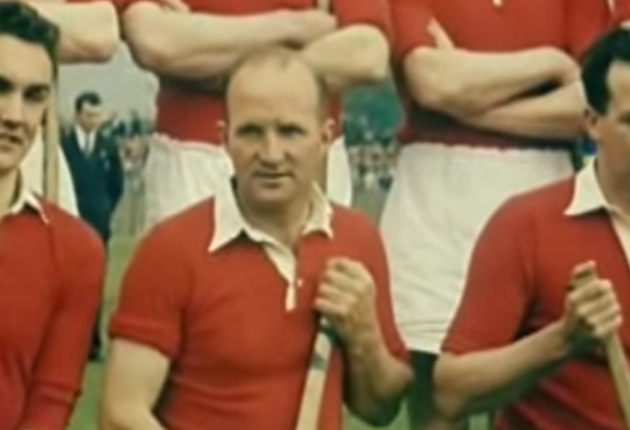CHRISTY RING IS the second subject in our series of articles focusing on the most important Irish sportspeople of the last 100 years. The list will include GAA players, Olympians, boxers, golfers and more who dared to dream.
If you look at the crest for Cloyne GAA club, you’ll see a round tower, 15 sliotars, two crosses, two hurleys and a football.
But what stands out most of all is the golden star, adorned by a single tear, at its very centre.
The star is for Christy Ring, Cloyne — and hurling’s — most famous son, the falling tear to acknowledge the fact he had to leave the club to play for Glen Rovers.
The vast majority reading this will probably never have seen Ring play and yet, even in a sport as storied as hurling, his name transcends all others. Playing his first senior match at 19 and calling it a day at 42, Ring togged out around 1,300 times for club and county, wowing anyone who saw him pick up a hurley and inspiring both verse and song:
Cork is bate
The hay is saved
The thousands wildly sing
They speak too soon
My sweet garsun
‘Cause here comes Christy Ring
Born on 12 October 1920 just outside the village of Cloyne, Ring was the second son of Mary and Nicholas with — so the legend goes — his father instilling an early grá for the small ball by sticking young Christy on his handlebars and cycling to Cork club games.
Much of Ring’s early years with the ash were spent playing in street leagues with his brothers before joining Cloyne GAA as a minor where he first gave a glimpse of the all-action style that would send fans into raptures and opponents into tears.
In 1937, Ring was selected as a substitute by Cork for the All-Ireland minor hurling final with Kilkenny a month short of his 17th birthday but he wouldn’t make his debut for the Rebels until the following May in a Munster minor championship encounter with Limerick.
1939 brought his senior debut with both Cloyne and Cork, the start of a career that would see Ring tog out close to 1,300 times for both club and county. While he is remembered for his flair, Ring was also teak tough famously telling Seanie O’Leary — who was leaving the pitch bashed and bloodied having take a belt of a hurley to the face — to “get back out here, you don’t play hurling with your nose.”
Ring would win the first of his then-record eight All-Irelands with Cork in 1941 in rather unusual circumstances. With foot and mouth disease rife in Munster and Leinster, both Tipperary and Kilkenny were barred from participating in that year’s championship.
As a result, Cork hammered Dublin 5-11 to 0-6 to claim the Liam MacCarthy but actually lost the re-fixed Munster hurling final a month later to Tipperary.
In 1942, Ring won his first Munster senior title when Cork gained revenge on Tipperary before defending their All-Ireland crown with another facile victory over Dublin that September. Cork achieved the three-in-a-row in 1943, a 5-16 to 0-4 demolition of Antrim giving the 22-year-old yet another Celtic Cross.
It was during the 1944 Munster final replay, however, that Ring really emerged as hurling’s top billing. According to reports at the time, with minutes remaining, Ring picked up the sliotar in his own half-back line before soloing his way through numerous Limerick defenders.
Steadying himself 40-yards out, Ring fired home into the roof of the net and the game was won. Once again, Cork played Dublin in the All-Ireland decider and the Rebels easily made it four-in-a-row on a 2-13 to 1-2 scoreline.
Ring would play in six more All-Ireland finals, winning four (1946, 1952, 1953, 1954) and losing two (1947 and 1956), the last of which came when he was 36. While many expected him to retire, he continued to play and it wasn’t until 1964 — after a then-record 64 championship appearances — when he declined to be listed as a substitute for the All-Ireland final that his playing days with his county came to an end.
When Ring died in 1979 at the age of just 58, an estimated 60,000 people lined the streets of Cork for his funeral with Taoiseach Jack Lynch — a former inter-county team-mate — giving the graveside oration in which he outlined his former colleague’s importance to the national psyche:
As long as young men will match their hurling skills against each other on Ireland’s green fields, as long as young boys swing their camans for the sheer thrill of the feel and the tingle in their fingers of the impact of ash on leather, as long as hurling is played, the story of Christy Ring will be told. And that will be forever.”
There’s a tradition in Cork that when Glen Rovers — where Ring played most of his club hurling – win the senior hurling championship, they leave Páirc Uí Chaoimh en-route back to their club and stop to walk the cup over the river Lee.
When they won just their second title since his death last season, the ritual had an added poignancy as Rovers players and supporters stopped with the Seán Óg Murphy Cup on the Christy Ring Bridge, showing once more his continued importance to the sport, despite last togging out more than 50 years earlier.
Over the next four months, in association with Allianz Insurance, we’ll be profiling the 16 most important Irish athletes of the last 100 years.
Allianz Insurance — The world belongs to those who dare.



